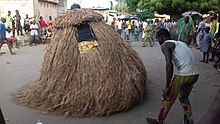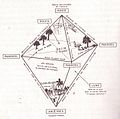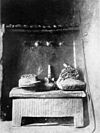Portal:Traditional African religions
Introduction The beliefs and practices of African people are highly diverse, including various ethnic religions. Generally, these traditions are oral rather than scriptural and are passed down from one generation to another through folk tales, songs, and festivals, and include beliefs in spirits and higher and lower gods, sometimes including a supreme being, as well as the veneration of the dead, and use of magic and traditional African medicine. Most religions can be described as animistic with various polytheistic and pantheistic aspects. The role of humanity is generally seen as one of harmonizing nature with the supernatural. In the past, African religion used to be referred to as 'traditional' but this is no longer appropriate. 'Traditional' was used to distinguish Africa religion from Abrahamic religion which came to the continent as a result of proselytism. Colonialism supported the false view that Africa had no religion. (Full article...) Selected articleThe Battle of Fandane-Thiouthioune also known as the Battle of Somb occurred on 18 July 1867. It was a religious war between the Serer people who adhered to the tenets of Serer religion and the Muslim Marabouts of 19th century Senegambia who came to convert them through jihad. Although religious, it also had a political and economic dimension to it: vendetta and empire-building. Fandane, Thiouthioune and Somb were part of the pre-colonial Serer Kingdom of Sine now part of independent Senegal. The Serer people defeated the Muslims and killed their leader. Selected imagesFestivalsThere are several religious festivals found in the various Traditional African religions. Some of these are listed below next to their corresponding religion :
Selected biographyBabacar Sedikh Diouf (Serer: Babakar Sidiix Juuf) is a Senegalese historian, author, researcher, campaigner against "Wolofization", a Pan-Africanist, and former teacher. He has written extensively about the history and culture of Senegal, Africa, and that of the Serer ethnic group to which he belong. He usually writes by the pen name Babacar Sedikh Diouf. Diouf was one of the first (if not the first) to explain the Serer religious significance of the Senegambian stone circles. His work published on July 7, 1980 on the Senegalese newspaper Le Soleil became headline news and was picked up by the prehistorian and archaeologist Professor Cyr Descamps and his colleague Professor Iba Der Thiam. Professor Descamps was one of the archaelogisgts who excavated the monuments back in the 1970s. On July 28, 1980, Professor Descamps issued a response to Diouf—thanking him for explaining the significance of the Senegambian megaliths which until then were unknown or undocumented. Some of that included the arrangement of the stones and their religious symbolism based on Serer numerlogy. In his joint paper with Iba Der Thiam – titled: La préhistoire au Sénégal: recueil de documents, published in 1982, Descamps and Thiam republished Diouf's work and reiterated their thanks to him for his work two years earlier. Selected quote
On the influence of African religion on art, Aloysius M. Lugira (2009), quoting Ladislas Segy (1975), Source: African Traditional Religion, Third Edition, 2009 by Aloysius M. Lugira, quoting Ladislas Segy, "African Sculpture Speak",Da Capo Press (1975), p. 118, ISBN 9780306800184
Did you know
Related portalsTopicsFor more Traditional African religion topics, see Category:Traditional African religions.
CategoriesWikiProjectsThings you can doAssociated WikimediaThe following Wikimedia Foundation sister projects provide more on this subject:
Discover Wikipedia using portals |





































